Increase your offshore success with this innovative big-game rig.
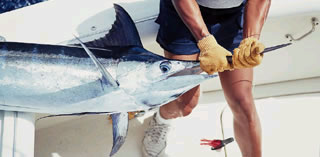 Anglers find it safer and easier to release a fish caught on a single hook. It's better for the fish, too. |
What's the most effective way to rig a marlin lure? The question has been debated ever since the first billfish was taken on an artificial, with most anglers falling into two major camps: double hook versus single hook. At first blush it might appear that the former offers a logical advantage; after all, wouldn't two hooks give you a better chance of hooking up? However, it seems that a growing number of big-game anglers have discovered this not to be the case, so they are switching to single-hook rigs '’’ and catching more fish as a result.
Single-hook rigs offer numerous benefits. Without the additional weight and profile of two hooks, lures tend to track straighter and perform better. Also, single-hook rigs are relatively less complicated and time-consuming to make (if you don't want to spend the money for pre-fab rigs). Furthermore, removing a single hook from the mouth of a fish is much safer and easier, and less stressful for the fish.
Early Rigs
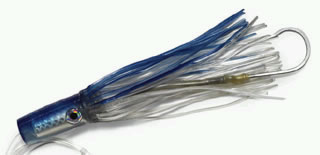 The success of the Gaff Rig lies in the placement of the single tuna-style hook and the use of slick shrink-tubing, which slides easily through the jaws of a billfish. |
Single-hook rigging has its origins with Red Bailey, the well-known St. Thomas charter captain. Once a proponent of trolling big natural baits such as mackerel, Bailey rigged with single hooks and fished a very light drag so that his inexperienced charters could transfer the rod to the fighting chair, advance the drag and come tight to the fish without assistance from the crew. Since the marlin didn't feel any resistance during the rod transfer, they held onto the baits longer, and Bailey's catch numbers soared.
Bailey eventually applied his single-hook, dropback technique to lure fishing. Using mostly Mold Craft lures and stiff No. 19 wire with a single hook, he discovered that the marlin would hold onto the soft lures long enough for his anglers to transfer the rod to the fighting chair, strap on the harness and set the hook. What's more, when the drag was advanced to the strike position, the marlin was usually swimming parallel to the transom or away from it, which produced a better angle for setting the hook.
Once word of Bailey's success began to spread, several pro-circuit boats picked up on the technique. In 1991, Mold Craft president Frank Johnson and I traveled to Costa Rica's Flamingo Bay in order to test the single-hook/modified-dropback technique. At one point we were trolling a spread of single-hook lures aboard Captain Richard Chellemi's Gamefisher II when an 800-pound blue marlin picked off the lure on the close flat line. Since we were using only three pounds of drag, I was surprised that the marlin wasn't taking line at a faster pace '’’ until I figured out that fish didn't realize it was in trouble. By the time I had transferred the outfit to the fighting chair, donned the harness and advanced the drag, the fish had turned back toward the spread as if intending to pick off another lure!
Although single-hook rigs rode a wave of popularity for a while, they eventually returned to their 'back-seat'� status. However, now they are making another comeback due to some fine-tuning that has greatly improved their effectiveness. It's important to note that these updated rigs work best when fished on a full strike drag and with the line run from a tag line or outrigger clip. Dropping back is not necessary, although it can be done.
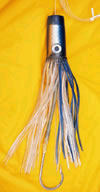
The setup shown in the accompanying photos is called the Gaff Rig, and is the bread-and-butter rig of several pro marlin fishermen. One of the key features is the position of the hook '’’ the eye sits just inside the skirt '’’ which is barely IGFA legal. In addition, the rig relies on its smooth exterior, length and stiffness to help set the hook '’’ much like a gaff. This is aided by the layers of shrink tubing that bulk the rig up to the same diameter as the hook and cover the sleeves and hook eye.
Here's the theory behind the Gaff Rig's effectiveness: When a marlin attacks the lure, it generally aims for the head. As the fish turns with the lure and meets resistance from the drag, the smooth, stiff rig slides through its jaws, pulling the tuna-style hook into the side of its mouth. The mechanics aren't too unlike those involved in gaffing a fish, hence the name.
Some anglers are taking the fine-tuning process a step further. By inserting a nylon stop sleeve, or even a toothpick or two (depending on the diameter of the leader channel in the lure head), the hook can be held in a specific position. For instance, several pros have discovered that their hook-up rates have risen considerably when the hook is locked in an upright position. When a marlin attacks from directly behind and eats the lure, it tends to be hooked more solidly and farther back in the upper to middle jaw.<
It should be noted that such fine-tuning works best with slanted- or cupped-head trolling lures that track at a specific attitude. Straight-cut lures tend to wobble more, making it difficult to keep the hook riding in a fixed position.
There are various styles of modern single-hook lure rigs out there that catch their share of fish. These include 'loose'� rigs, where the hook is attached to the leader without any reinforcement, and semi-stiff rigs that use plastic beads to add rigidity and adjust the distance between the hook and lure head. However, the Gaff Rig is one of the hottest single-hook marlin lure setups going. On the previous page are the steps involved in rigging a lure that can be fished on 50- through 130-pound-class tackle.
Building the Gaff Rig
|
1. 400-pound-test leader 2. 12/0 Mustad 7691 hook ('tuna-style'� hooks with curved-in bights seem to work best) 3. Momoi 'C'� and 'D'� sleeves 4. 1/8 x .015 wall nylon tubing (pre-measured to create the gap between the hook eye and lure head) 5. Two pieces 1/4" shrink tubing 6. Two pieces 3/8" shrink tubing 7. 1/16" nickel-copper, double-barrel sleeves 8. Lure (model shown is a Mold Craft Senior Wide Range) |
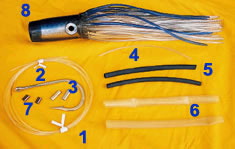 |
|
1. Pass the leader through the components in the following order: two 3/8" shrink tubes, two 1/4" shrink tubes, nylon tubing, 'C'� sleeve. Note: if the tubing curves slightly, stack the sections so they curve in opposite directions. |
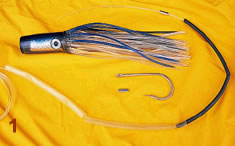 |
|
2. Add a 'D'� sleeve to the leader and then secure the hook to the leader with a Figure 8 loop that runs behind the hook eye. Before crimping on the hook, make certain the hook extends straight behind the leader. Snug down and crimp the connection. |
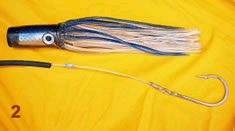 |
|
3. Lay the hook alongside the lure with its eye barely inside the skirt. Slide the 1/8 x .015 nylon tubing down to the crimp. Then slide the 'C'� sleeve on the opposite end of the nylon tubing so that it will keep the hook at the predetermined distance from the lure head. Crimp the sleeve. 4. Slip the first of the thinner shrink tubes over the nylon tubing and crimps, then shrink it (do this carefully to avoid damaging the leader). Slip the second of the thinner shrink tubes over the first section and shrink. Follow by sliding the first of the wider shrink-tube sections over the smaller ones and shrinking it, then do the same with the second wide tube. Note: make sure the wide shrink tubes cover the mono leader around the hook eye and shank, as well as the positioning crimp on the nylon tubing. This is how the rig's diameter is built up to match that of the hook shank, and where its gets its uniformity and smoothness. |
 |
|
5. Slide lure onto the opposite end of the leader and insert the exposed section of nylon tubing into the lure head. This will keep the hook riding at a fixed position and the proper distance behind the lure head. 6. To complete the rig, form a loop in the end of the leader and crimp with the 1/16" double-barrel sleeves. Note: If wahoo cut-offs are a concern, substitute the monofilament terminal rig with one fabricated from 7-by-7, 480-pound cable, as shown above. |
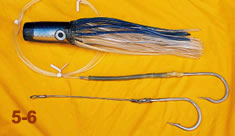 |

